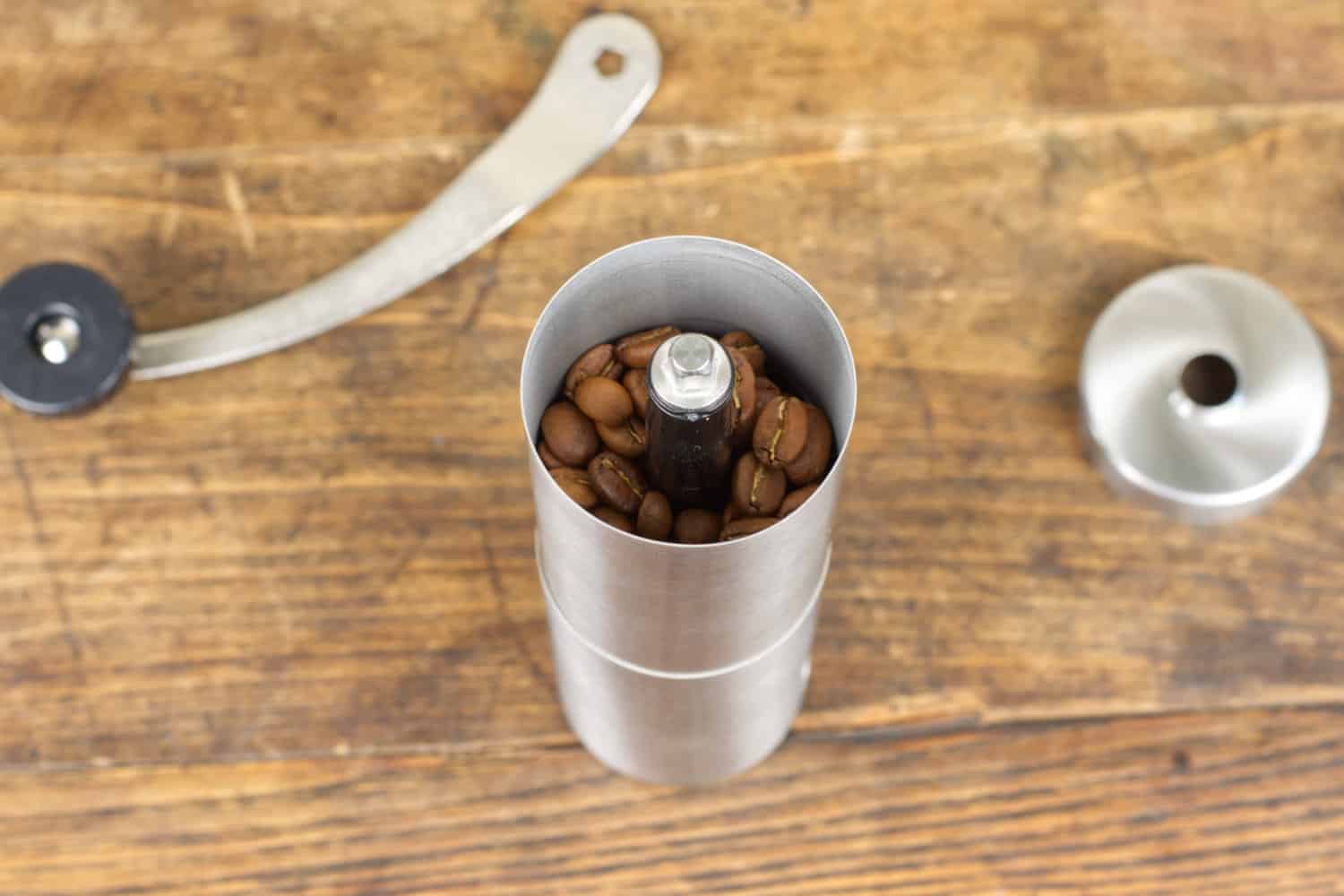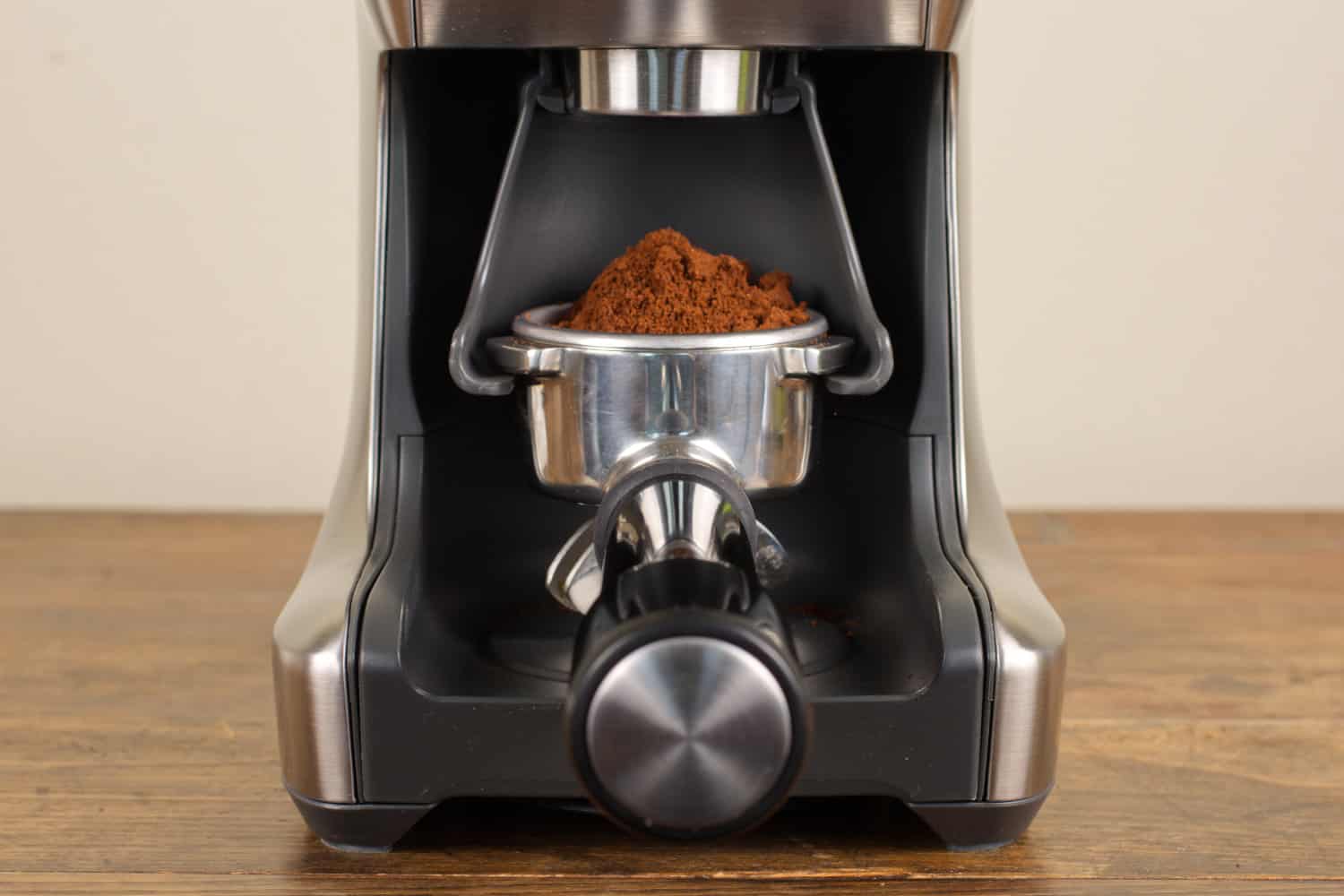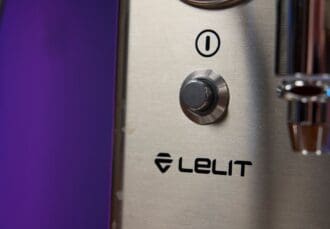Regular Coffeeness readers will already know that I always encourage you to grind your coffee beans fresh, right before you brew. What’s more, I like to encourage anyone who is still using a blade coffee grinder to throw it in the trash and buy the best burr coffee grinder they can afford. But should you buy a manual or electric coffee grinder?
In today’s guide I’ll attempt to steer you in the right direction, based on your lifestyle, budget and coffee brewing preferences. I’ll discuss the pros and cons of each grinder type and even throw in a few tips for getting the best out of your grinder. Let’s do this!
Table of Contents
How Important Is a Grinder in Your Coffee Setup?
Put simply, a consistent grind size is absolutely essential for a well-balanced coffee extraction. Seriously, it doesn’t matter which brew method you’re using. Here’s why: If your ground coffee is a mix of uneven sized particles, you’ll end up with a mix of bitter and sour flavors in your cup. That’s because each particle will have a different surface area, so you’re looking at simultaneous over- and under-extraction.
Blade coffee grinders are notorious for producing uneven results, seeing as they just chop up your coffee beans. That’s why your French press coffee will always taste muddy and your pour over will be both bitter and weak. Of course, not all burr coffee grinders are created equal. Still, even the cheapest burr grinder will produce better results than any blade model.
| Consistent Grind (Burr) | Inconsistent Grind (Blade) | |
|---|---|---|
| Extraction | Even, predictable and repeatable | Uneven and chaotic |
| Flavor profile | Balanced and complex | Muddy and incomplete |
| Result in cup | Well-rounded flavor profile | A mix of bitter and sour notes |
What Is a Manual Coffee Grinder?
Whether it’s a budget-friendly model like the Porlex Mini or the boutique Comandante C40, a manual coffee grinder works on the same principle: you put in coffee beans at the top, then use a hand-crank to manually crush the beans between a set of burrs. The resulting ground coffee then passes into a chamber at the bottom of the device.
Naturally, more expensive models will have superior burrs and construction, as well as a wider spectrum of grind size adjustments. With that said, I’ve gotten great results from very inexpensive models like the JavaPresse Manual Coffee Grinder.
Either way, using a hand grinder offers a tactile, ritualistic experience that I love. What’s more, you’ll get a whole lot more bang for your buck when buying a manual grinder, which is an attractive proposition if you’re an espresso aficionado on a budget. And the fact that your hand grinder is compact and travel-friendly can be a huge bonus.
What Makes a High-Quality Burr Hand Grinder?
I’ve tested tons of manual coffee grinders at a range of price points, and there’s a huge difference between a budget-friendly model and a more premium device.
For starters, a high-quality burr hand grinder will be equipped with larger, more precision engineered stainless steel conical burrs. Not only that, the materials used in the grinder’s construction will be noticeably more durable and high-quality. You can also expect a much more stable central axle, which will make the grinding process easier and more efficient. Finally, a high-quality burr hand grinder will offer a more sophisticated grind adjustment mechanism, allowing you more control over your grind size.
A great example is the 1Zpresso J Max, which has been designed for espresso enthusiasts. This incredible grinder features an external grind adjustment dial, with each click moving the burrs just a few microns. What’s more, its thoughtful design and premium materials make it a joy to use.
What Are the Pros and Cons of Manual Grinders?
As I mentioned earlier, one of the major benefits of a manual grinder is its price-performance ratio. Essentially, you’ll spend much less for excellent grind quality than you would on an electric coffee grinder. What’s more, a hand grinder is extremely portable, close to silent and doesn’t require electricity. This makes it ideal for those who want to make high-quality coffee while traveling or camping.
Of course, the glaring drawback to using a manual coffee grinder is that it requires physical effort. Plus, it’ll take longer to grind your required dose of ground coffee than it would with an electric model. And while more premium hand grinders make it easy on your arms, you can only grind limited amounts at a time. So, if you’re used to making a full carafe of coffee for your family each morning, be prepared to put in considerable time and effort!
What Is an Electric Coffee Grinder?
As I’m sure you already know, an electric coffee grinder uses a motor rather than your muscle power to move the burrs. This automation means an electric coffee grinder provides a quick and convenient way to grind larger quantities of coffee beans. Heck, all you have to do is select your grind size, push a button and wait for the grinder to do its thing.
As with hand grinders, there’s a wide spectrum of electric burr grinders on the market, and you can spend a lot of money on an espresso grinder like the Eureka Atom 65. Still, unless you’re a demanding home barista or dedicated pour-over freak, you can expect quick, consistent and convenient grinding from a relatively affordable model like the Baratza Encore or Breville Smart Grinder Pro.
How Do Electric Grinders Work?
Ultimately, an electric grinder works in the same way as a manual grinder in that coffee beans are crushed between two hard, rotating surfaces (burrs). However, in an electric grinder, there’s a motor which provides consistent rotational speed. And as I’m sure you’ve already guessed, it’s this consistent speed that allows for uniform grinding.
With that in mind, an electric grinder’s motor is a crucial element in its design, and high-end grinders usually have more sophisticated, lower speed motors installed. That’s because when the burrs rotate at slower speeds, less heat is created, thereby preserving the coffee’s delicate aroma. Plus, a low-speed motor will be quieter and produce less static charge. Finally, high-quality motors often employ gear-reduction mechanisms to reduce the speed while maintaining a powerful and consistent rotation, which results in superior grind consistency.
Conical vs Flat Burrs: What’s the Difference?
Ah, the great conical vs flat burr debate! As it happens, this is quite a divisive subject in some circles, so don’t expect me to play favorites. However, I will give you the lowdown on the difference between the two types of burrs.
Conical burrs are what you’ll find in most home grinders, seeing as they’re less expensive and can be used at lower speeds. There’s a metal or ceramic cone that spins within a stationary outer ring, grinding the coffee beans as they fall through. The benefits to using conical burrs include less grind retention and reduced heat buildup. However, conical burrs struggle to produce a truly uniform grind size.
Flat burrs are more common in prosumer and commercial coffee grinders, and excel for espresso. Comprising two spinning discs, flat burrs employ centrifugal force, meaning they have to spin very fast. While this can result in more heat and static buildup, there’s no denying the fact that flat burrs can produce exceptional particle uniformity. With that in mind, you can expect cleaner and more delicate extractions when using a flat burr grinder.
| Flat Burrs | Conical Burrs | |
|---|---|---|
| Grind distribution | Unimodal: Narrower distribution, with more uniform particle sizes | Bimodal: Wider distribution, with more variation in particle sizes |
| Flavor profile | Emphasizes brightness, clarity and flavor complexity (highlighting individual flavor notes) | Emphasizes body, balance and sweetness (a more integrated flavor profile) |
| Fines production | Produces fewer fines (this enhances cup clarity) | Produces more fines (this increases extraction) |
| Body | Lighter, cleaner body with more texture definition | Fuller, heavier body with more mouthfeel |
What Are the Pros and Cons of Electric Grinders?
I’d say that the advantages to using an electric coffee grinder are fairly self-evident. I mean, an electric grinder is fast, easy to use and can produce large volumes of ground coffee at the push of a button. Furthermore, it’s often the case that an electric grinder will offer a wider range of grind settings than a manual coffee grinder.
On the flip side, you’ll have to shell out more money for a good electric coffee grinder, and you can’t really throw it in your backpack and go camping with it. Plus, whereas a manual grinder can be stored in a cupboard, you’ll need dedicated kitchen counter space for an electric model.
Finally, all but the most expensive electric grinders are going to be rather noisy. Like, wake-the-baby-first-thing-in-the-morning noisy.
Manual vs Electric Coffee Grinder: A Head-to-Head Comparison
Now that you have a better idea of how manual and electric coffee grinders work, let’s get to comparing them!
| Manual Grinder | Electric Grinder | |
|---|---|---|
| Grind consistency | Moderate with cheaper models, very good with mid-range / expensive models | Generally very good. Exceptional with premium models |
| Cost | $30-$500 | $100-$2,000+ |
| Speed & convenience | Requires time, effort and patience | Very fast and convenient |
| Portability | Can be carried and used anywhere | Not portable |
| Noise level | Almost silent | High noise levels, even with sound dampening |
| Capacity | Single dose | Large batches / single dose |
| Best for … | Coffee enthusiasts on a budget, travelers, etc. | Coffee lovers with a larger budget, those who value speed and convenience |
Grind Consistency
You can expect reliable grind consistency from an electric burr coffee grinder. However, cheaper models will struggle for consistency away from the middle of the grind size spectrum. As for manual grinders, it’s more difficult to achieve uniform particles seeing as you’re not a motor! However, more premium hand grinders allow for high levels of grind consistency because their superior build quality makes for smooth and steady operation.
Cost
Manual grinders range in price from around $30 to $400 or more. You can pick up a perfectly good manual coffee grinder like the Hario Mini Slim Plus for around $40. Then again, you can expect to find an outstanding performer in the $150-$200 range.
With electric coffee grinders, I’d recommend spending at least $100. At that price, you can expect to find a solid performer like the OXO Coffee Grinder. However, if you want an electric grinder that’s suitable for espresso, you’ll have to dig deeper into your pockets. And don’t forget that a cheap electric grinder might not stand the test of time.
Speed & Convenience
As I’ve already pointed out, an electric coffee grinder is much faster and more convenient than a hand grinder. Plus, it’s usually much easier to adjust grind settings on an electric model. With all that said, electric grinders can create quite a lot of mess, which is easy to avoid with a manual coffee grinder. Plus, cleaning and maintaining an electric grinder is a more involved process.
Portability
Manual coffee grinders are small, meaning they take up practically no counter space. What’s more, they’re easy to carry around. So, if you want to take your coffee grinder wherever you go, choosing a manual model makes sense. As for electric coffee grinders, they aren’t really designed for camping trips, although smaller models could be suitable for camper vans and RVs.
Noise Level
It kind of goes without saying that manual grinders win out in this regard. After all, there’s no motor to generate noise as the thing is grinding. Plus, if you’re worried about waking a particularly light sleeper, you could always just go sit in your car as you’re grinding for your morning coffee!
Capacity
Here’s where electric grinders definitely offer a more versatile option. You can grind much larger quantities of coffee in a very short amount of time with an electric grinder, making it an ideal choice if you’re pulling back-to-back shots of espresso or brewing up a pot of drip coffee.
Meanwhile, manual grinders are way more suited to single dosing or preparing a cup of pour-over coffee. That’s because a hand grinder’s catch cup is on the small side and it takes a lot of time and effort to grind.
Best For …
Without a doubt, buying a manual coffee grinder makes sense if you’re on a limited budget and want consistent results. What’s more, you can get a seriously good hand grinder for espresso without having to break the bank. Then again, it’s important to remember that even the best manual coffee grinders require significant time and effort for smaller doses of coffee.
An electric grinder is best for those who are willing to spend more money for freshly ground coffee. And as long as you have sufficient space in your kitchen, an electric grinder is ideal for producing larger quantities of coffee grounds.
How Do You Adjust the Grind on Manual vs Electric Grinders?
In the majority of cases, you adjust the grind on a manual grinder by using a dial located just below the burrs. This means that you have to remove the coffee grounds catch cup. And while that isn’t a huge deal, it can feel a little fiddly. On the other hand, this tactile approach is pretty cool in that you can literally feel every click as you’re moving the burrs. Incidentally, the best 1Zpresso grinders use an external grind adjustment dial, which allows for many more settings.
With electric grinders, there’s a wide array of grind adjustment mechanisms. For the most part, you’ll change settings by turning a dial located below the hopper. And while more affordable electric grinders have a specific number of settings, you’ll find that some of the best espresso grinders offer stepless systems for infinite settings. Either way, you’ll have a hard time finding a true “all rounder.” That’s because there’s a big difference between the super fine grind size required for espresso and the coarse size used for French press.
Manual vs Electric Grinders: Which Offers Better Value?
There’s no getting around the fact that manual coffee grinders offer far better value at lower price points. Put another way, if you spend around $200 on a hand grinder, you can expect to achieve vastly superior performance than if you spend the same amount on an electric model. Of course, a high-end burr grinder offers better value if you value speed and convenience, but you’re going to have to invest a significant chunk of cash upfront.
If you’re on a tight budget and want to brew the best coffee possible, I recommend looking into the manual grinders you can afford. For example, if you don’t mind putting in the manual effort each time you brew, you can pick up a superb hand grinder for under $100. Trust me, it’ll outperform any electric grinder at the same price point. What’s more, an affordable manual grinder will last a whole lot longer seeing as it has fewer potential points of failure.
Beyond the Basics: Workflow, Dosing and Daily Use
A deciding factor in your own personal manual vs electric coffee grinder debate could be your daily coffee-making routine. Essentially, it all comes down to how you make coffee, how much you make at a time and how invested you are in the process.
A manual coffee grinder is ideal for single-dosing workflow, wherein you weigh your coffee beans and grind a single dose for your preferred brewing method. This not only maximizes freshness, but also allows you more precision-based results. And while there are plenty of single dose electric grinders on the market, you’ll have to spend a lot more money to get hold of one.
The majority of budget-friendly and mid-range electric grinders are hopper-fed. And while many hoppers are tinted and have sealed lids, there’s no escaping the fact that your coffee beans are going to go stale faster. With that said, hopper-fed grinders offer speed and convenience, both of which are priorities for a lot of folks.
How to Clean and Maintain Your Coffee Grinder
As I’m sure you already know, regular cleaning is crucial for coffee taste and grinder longevity. Whether you own a manual or electric coffee grinder, you’ll need to disassemble the thing on a regular basis in order to keep the burrs free of old grounds and coffee oils. What’s more, you may want to run coffee grinder cleaning tablets through your electric grinder to thoroughly clean the system.
If you own a manual grinder, it’s fairly easy to keep the thing clean. I always recommend brushing off excess coffee grounds after each use, as well as gently tapping the grinder on a hard surface to loosen grounds caught in the chamber. With an electric grinder, you should try and brush out the burr chamber and grounds chute as best you can. Oh, and a vacuum cleaner will actually come in very handy too.
With both types of grinder, removing the top burr shouldn’t be very difficult. However, some electric grinders may require a special tool. Once you’ve removed the burr, make sure to brush it off, then wipe off any coffee oils. After all, those oils can go rancid, and you can guess what that’ll mean for the taste of your coffee.
The Final Verdict: Which Grinder Is Right for You?
When considering manual vs electric coffee grinders, it’s clear that there’s no “winner.” Rather, both have their benefits and drawbacks. If I’m being honest, I recommend that you own at least one of each. Still, I’m very aware that owning multiple coffee grinders isn’t realistic for everyone.
So, if you have to decide between buying a manual or electric grinder, think carefully about what kind of coffee drinker you are. For example, if you’re a traveling coffee lover, a manual grinder would make the most sense. The same goes for espresso hobbyists on a budget. On the other hand, if you’re a busy morning brewer who needs to quickly brew up a pilot of coffee for your family, I’d recommend buying a decent electric grinder.
At the end of the day, all that really matters is grinding coffee fresh and ignoring blade grinders altogether. And whether you achieve that using a manual or electric grinder, your coffee beans will thank you!
I hope you’ve enjoyed this manual vs electric coffee grinder guide. What’s your favorite coffee grinder? Feel free to share your thoughts in the comments section!
Manual vs Electric Grinder FAQ
Some manual coffee grinders are expensive because they are made from high-quality materials and offer ultra-precision grinding. However, there are plenty of budget-friendly models that perform really well.
Manual coffee grinders aren’t necessarily better than electric grinders for taste. However, you can pick up an exceptional manual grinder for a fraction of the cost of an electric grinder with similar performance.
In general, manual grinders last longer than electric grinders because they have fewer moving parts and don’t have motors.










